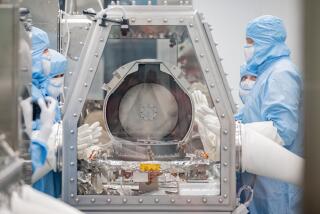Astronomers spot spiral arms swirling around a young star, offering clues to planet formation
An international team of astronomers has discovered what might be the first evidence of density-driven spiral arms in the gas and dust around a still-forming star.
The findings, described in Friday’s edition of the journal Science, could offer an unprecedented glimpse at a key stage in a young star’s life and may shed light on the early evolution of planets.
Young stars collect a disk of gas and dust that rotates around the star, and that disk can give rise to planets — some small and rocky, others large and gaseous — that form out of the debris. (Other denizens of the void, such as asteroids and comets, are thought to be chunks of coalesced material that never quite made it into a full planet.)
In its youth, a growing star’s disk can be pretty bulky, and scientists think that gravity causes much of that mass to gather into spiral arms, somewhat akin to the way a galaxy like the Milky Way develops its pinwheel shape. These arms might be key to planetary formation, said study coauthor Sean Andrews, an astronomer at the Harvard-Smithsonian Center for Astrophysics, because without these regions of greater density, planets probably wouldn’t be able to form in a time frame that makes sense.
“It takes too long, basically — about the same as the lifetime of the disk,” he said. “So it seems like it would be hard to do, to make particularly giant planets in that way.”
But the existence of gravitationally triggered “spiral density waves” has been very difficult to pin down. Astronomers have found signs of spiral arms in the disks of stars, but it’s unclear whether they’re caused by the disk’s gravitational instability — which could then give rise to planets — or whether some already-existing planets are causing the spiral arms to form.
“There’s a bit of a chicken-and-egg thing in this,” Andrews said.
This early stage in the disk’s evolution has remained shrouded in mystery in part because it’s hard for telescopes to see what’s happening, said Ken Rice, a computational astrophysicist at the University of Edinburgh in Scotland who was not involved in the study.
“The self-gravitating phase, if it occurs, happens when the protostellar system is very young, the disk is still massive, the accretion rate is still high, and the system is still probably embedded within its nascent gas cloud,” Rice wrote in a commentary that accompanies the paper. “Consequently, directly observing these self-gravitating structures is very difficult.”
But thanks to the Atacama Large Millimeter/submillimeter Array, or ALMA, astronomers have been able to examine the structure in radio wavelengths that can see through gas and dust clouds, and at a much higher resolution than before.
For this study, the team focused on a young star known as Elias 2-27, which lies about 450 light-years away in what’s called the Ophiuchus star-forming complex. With only 50% to 60% of the mass of our sun, this is a fairly small star — but it has an oversized protoplanetary disk, close to a quarter of the star’s mass. Elias 2-27, which is at least a million years old, probably still has plenty of growing to do, and is pulling in mass from the disk at a rate of about 159 million trillion metric tons per year.
Scientists aren’t sure how micron-sized dust grains grow into the mile-sized planetesimals that are thought to be the building blocks of planets, Rice said. These disks could help to fill in that gap in our understanding.
“It is likely that this stage will be important for both the formation of the star itself and the subsequent formation of a planetary system,” Rice noted. “These observations will therefore play a crucial role in improving our understanding of both star and planet formation.”
At the moment, however, it’s not entirely clear whether these spiral arms were truly caused by density waves, or whether they’re the result of existing planets throwing their weight around.
Either way, the findings could offer clues about how both gassy and rocky planets form, Andrews said.
“I don’t really personally have an attachment to one mechanism or the other,” he said.
The important thing was seeing how much complexity lies within the disk, he added. Clearly the protoplanetary disk isn’t some smooth, symmetrical structure, as scientists once thought.
Andrews hopes to get a deeper look into the forces at play soon — he and his colleagues are planning to use ALMA to study several young star systems to see whether they have similar spiral arms. Examining their disks’ structure at this early stage — whether the arms are thick or thin, for example — could reveal how they influence the growth of planets.
Follow @aminawrite on Twitter for more science news and “like” Los Angeles Times Science & Health on Facebook.
MORE IN SCIENCE
It’s official: Rosetta’s long journey with comet 67P has ended
How science would fare under a Clinton or Trump administration
Eye-tracking technology shows that preschool teachers have implicit bias against black boys






